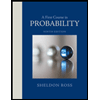
A First Course in Probability (10th Edition)
10th Edition
ISBN: 9780134753119
Author: Sheldon Ross
Publisher: PEARSON
expand_more
expand_more
format_list_bulleted
Question
I need help with solving these parts
![**Problem Statement:**
Let \( x \) have an exponential distribution with \( \lambda = 1 \). Find the probability. (Round your answer to four decimal places.)
\[ P(1 < x < 6) \]
**Answer Box:**
[Input box for response]](https://content.bartleby.com/qna-images/question/9175f245-2e1a-4def-805b-da74e3897838/042ffdca-6d4a-4497-b906-c44617289dd1/yzurtth_thumbnail.png)
Transcribed Image Text:**Problem Statement:**
Let \( x \) have an exponential distribution with \( \lambda = 1 \). Find the probability. (Round your answer to four decimal places.)
\[ P(1 < x < 6) \]
**Answer Box:**
[Input box for response]
![**Problem:**
Let \( x \) have an exponential distribution with \( \lambda = 1 \). Find the probability. (Round your answer to four decimal places.)
\[ P(x > 2) \]
---
**Solution:**
To find the probability \( P(x > 2) \), use the formula for the cumulative distribution function (CDF) of an exponential distribution:
\[ P(x > a) = 1 - F(a) = 1 - (1 - e^{-\lambda a}) = e^{-\lambda a} \]
For this problem, \( \lambda = 1 \) and \( a = 2 \):
\[ P(x > 2) = e^{-1 \times 2} = e^{-2} \]
Calculating \( e^{-2} \), we get:
\[ P(x > 2) \approx 0.1353 \]
Therefore, the probability that \( x \) is greater than 2 is approximately **0.1353**.](https://content.bartleby.com/qna-images/question/9175f245-2e1a-4def-805b-da74e3897838/042ffdca-6d4a-4497-b906-c44617289dd1/ts4253j_thumbnail.png)
Transcribed Image Text:**Problem:**
Let \( x \) have an exponential distribution with \( \lambda = 1 \). Find the probability. (Round your answer to four decimal places.)
\[ P(x > 2) \]
---
**Solution:**
To find the probability \( P(x > 2) \), use the formula for the cumulative distribution function (CDF) of an exponential distribution:
\[ P(x > a) = 1 - F(a) = 1 - (1 - e^{-\lambda a}) = e^{-\lambda a} \]
For this problem, \( \lambda = 1 \) and \( a = 2 \):
\[ P(x > 2) = e^{-1 \times 2} = e^{-2} \]
Calculating \( e^{-2} \), we get:
\[ P(x > 2) \approx 0.1353 \]
Therefore, the probability that \( x \) is greater than 2 is approximately **0.1353**.
Expert Solution
This question has been solved!
Explore an expertly crafted, step-by-step solution for a thorough understanding of key concepts.
This is a popular solution
Trending nowThis is a popular solution!
Step by stepSolved in 2 steps with 1 images

Knowledge Booster
Similar questions
arrow_back_ios
arrow_forward_ios
Recommended textbooks for you
 A First Course in Probability (10th Edition)ProbabilityISBN:9780134753119Author:Sheldon RossPublisher:PEARSON
A First Course in Probability (10th Edition)ProbabilityISBN:9780134753119Author:Sheldon RossPublisher:PEARSON

A First Course in Probability (10th Edition)
Probability
ISBN:9780134753119
Author:Sheldon Ross
Publisher:PEARSON
